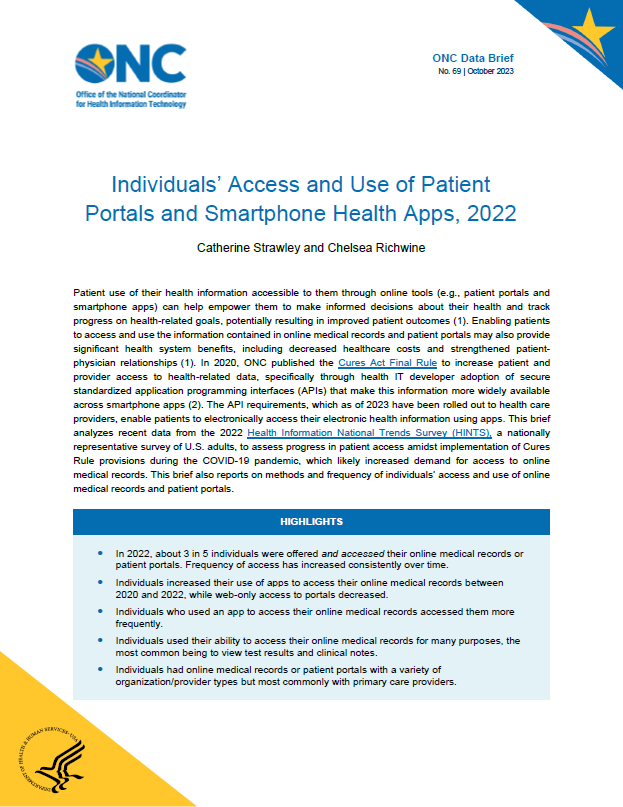Patient use of their health information accessible to them through online tools (e.g., patient portals and smartphone apps) can help empower them to make informed decisions about their health and track progress on health-related goals, potentially resulting in improved patient outcomes (1). Enabling patients to access and use the information contained in online medical records and patient portals may also provide significant health system benefits, including decreased healthcare costs and strengthened patient- physician relationships (1). In 2020, ONC published the Cures Act Final Rule to increase patient and provider access to health-related data, specifically through health IT developer adoption of secure standardized application programming interfaces (APIs) that make this information more widely available across smartphone apps (2). The API requirements, which as of 2023 have been rolled out to health care providers, enable patients to electronically access their electronic health information using apps. This brief analyzes recent data from the 2022 Health Information National Trends Survey (HINTS), a nationally representative survey of U.S. adults, to assess progress in patient access amidst implementation of Cures Rule provisions during the COVID-19 pandemic, which likely increased demand for access to online medical records. This brief also reports on methods and frequency of individuals’ access and use of online medical records and patient portals.
HIGHLIGHTS
- In 2022, about 3 in 5 individuals were offered and accessed their online medical records or patient portals. Frequency of access has increased consistently over time.
- Individuals increased their use of apps to access their online medical records between 2020 and 2022, while web-only access to portals decreased.
- Individuals who used an app to access their online medical records accessed them more frequently.
- Individuals used their ability to access their online medical records for many purposes, the most common being to view test results and clinical notes.
- Individuals had online medical records or patient portals with a variety of organization/provider types but most commonly with primary care providers.
The share of individuals nationwide who were offered and accessed their online medical record or patient portal more than doubled between 2014 and 2022.
FINDINGS
★ About 3 in 4 individuals nationwide reported being offered online access to their medical records by their health care provider or insurer in 2022 – this represents a 24 percent increase since 2020.
★ About 3 in 5 individuals nationwide reported they were offered and accessed their online medical record or patient portal in 2022 — this represents a 50 percent increase since 2020.
Figure 1: Percent of individuals nationwide who were offered and accessed their online medical record or patient portal, 2014-2022.
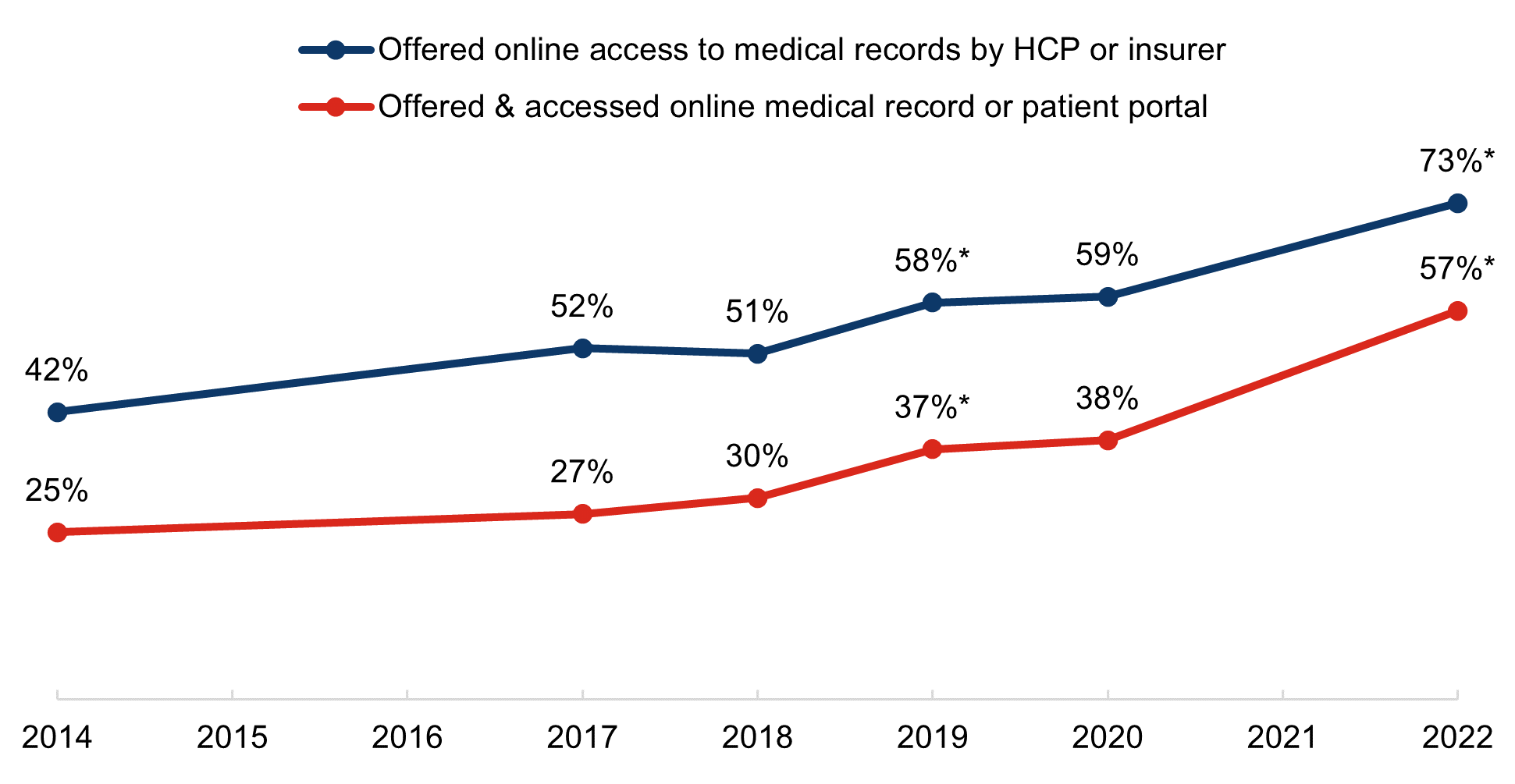
Source: HINTS 4 Cycle 4 (2014); HINTS 5, Cycles 1-4 (2017-2020), HINTS 6 (2022).
Notes: *Significantly different from previous year (p<0.05). Denominator represents all individuals. Percentage reflects weighted national estimate for individuals offered online access to their medical records by a health care provider or insurer and the share of individuals who were offered and accessed their online medical record or patient portal at least one in the past 12 months. The HINTS survey was not fielded in 2015, 2016, or 2021.
Individuals reported accessing their online medical records more frequently in 2022 than in prior years.
FINDINGS
★ More than half of individuals who were offered online access to their medical records reported accessing them at least 3 times in 2022, with nearly 1 in 3 accessing it 6 or more times.
★ In 2022, only 1 in 5 individuals reported not accessing their online medical records in the past year, a more than 50 percent reduction since 2017, when nearly half of patients offered online access to their medical records did not access them.
Figure 2: Frequency of individuals accessing their online medical records within the past year, 2017-2022.
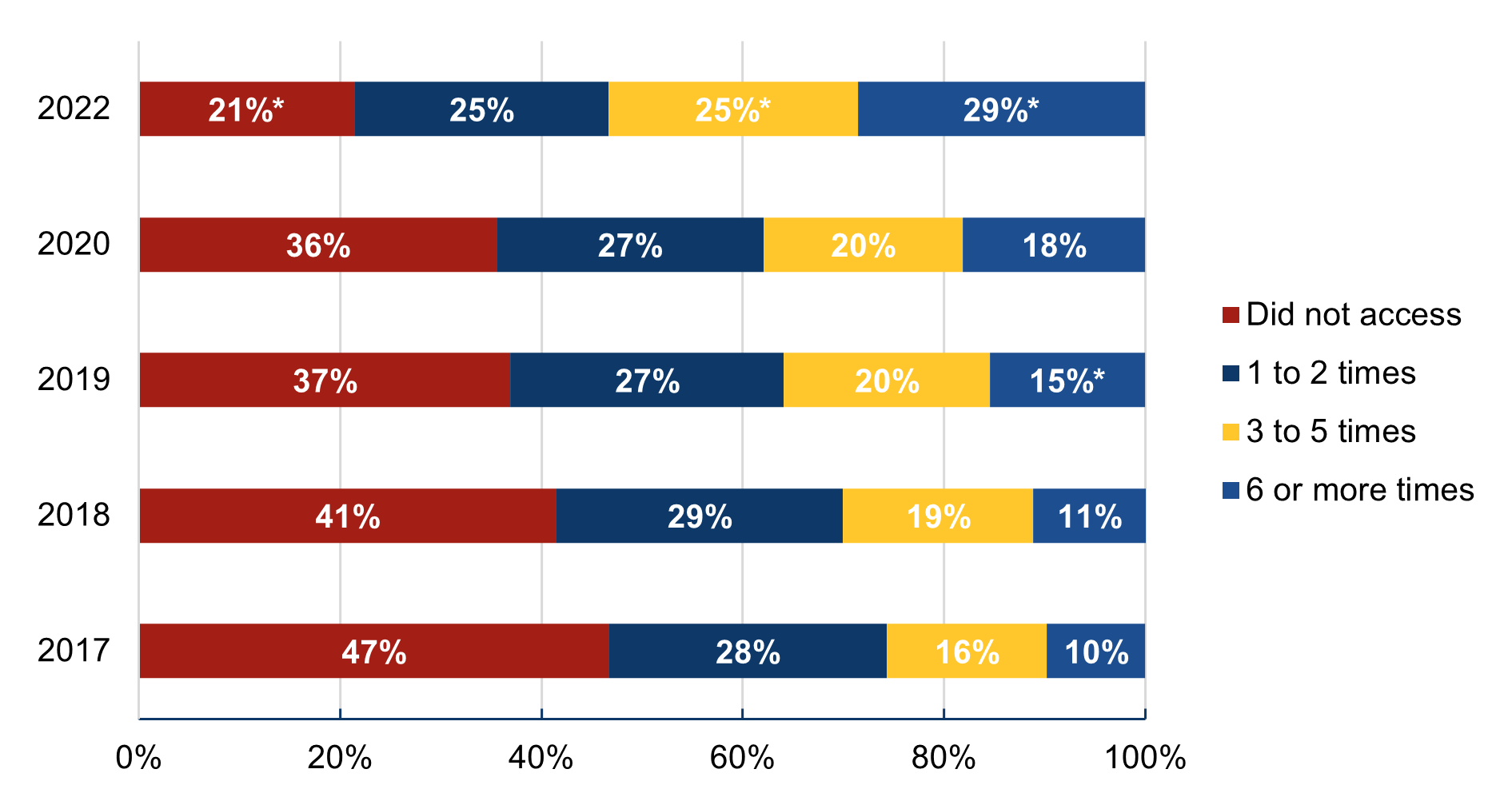
Source: HINTS 5, Cycles 1-4 (2017-2020).
Notes: *Significantly different from previous year (p<0.05). Numbers may not sum to 100 due to rounding. Denominator represents individuals who were offered online access to their medical records by a health care provider or insurer for each year.
Individuals’ use of apps to access their online medical records increased significantly between 2020 and 2022, while web-only based access to portals decreased.
FINDINGS
★ In 2022, nearly half of individuals who accessed their online medical records (48%) did so using a website only, whereas 19 percent used an app only and about one third (32%) used both an app and website (Panel A).
★ Half of individuals who accessed their online medical records used an app (only or in addition to a website) to access their records in 2022, representing a 13 percentage-point increase from 2020 (Panel B).
Figure 3: Methods individuals used to access their online medical records, 2020-2022.
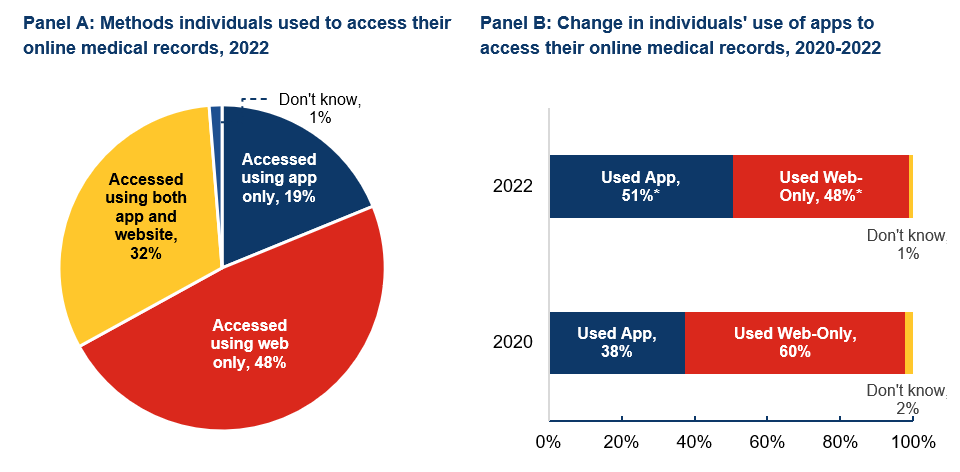
Source: Panel A: HINTS 6 (2022), Panel B: HINTS 5, Cycle 4 and HINTS 6 (2022).
Notes: Denominator represents individuals who accessed their online medical records at least once within the past year. In Panel B, “Used Web-Only” is equivalent to web only access in Panel A whereas “Used App” includes individuals who accessed their online medical records using an app only (19%) or using both an app and website (32%).*Significantly different from previous year (p<0.05).
Individuals who used an app to access their online medical records accessed them more frequently than those who did not use an app (web-only access).
FINDINGS
★ In 2022, rates of frequent access (6 or more times in the past year) were significantly higher among individuals who accessed their online medical record using an app compared to those who used only a web-based method (42% vs. 28%).
★ Only 26 percent of app users reported infrequent access (1 to 2 times in the past year) compared to 40 percent of individuals who accessed via web-only.
★ A similar share of those using an app and using the web to access their online medical records reported accessing their online medical records 3 to 5 times in the past year.
Figure 4: Frequency of individuals seeking access to their online medical records within the past year by method used, 2022.
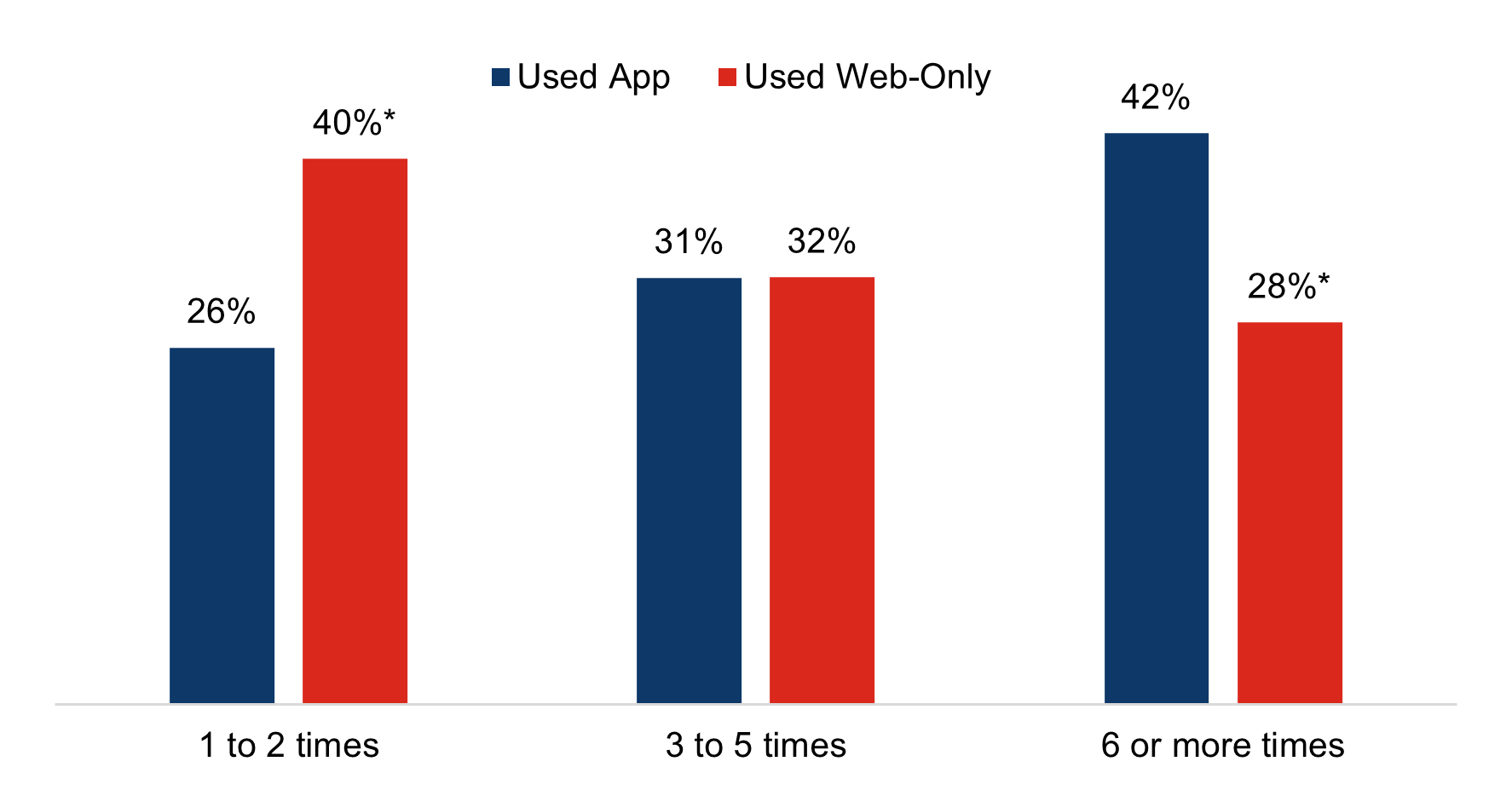
Source: HINTS 6 (2022).
Notes: Denominator represents individuals who accessed their online medical records or patient portal at least once within the past year. *Significantly different from reference group (p<0.05).
In 2022, the most common drivers behind access to online medical records were viewing test results and clinical notes.
FINDINGS
★ In 2022, most individuals who accessed their online medical records or patient portal viewed test results (90%) or clinical notes (70%).
★ About 1 in 3 patient individuals who accessed their online medical records or patient portal downloaded their health information, and 1 in 5 electronically transmitted medical information to a 3rd party.
★ There were no notable changes in individuals’ use of their online medical records or patient portal for specific purposes between 2020 and 2022.
Figure 5: Percent of individuals who used their online medical records or patient portal to view, download, or transmit information, 2022.
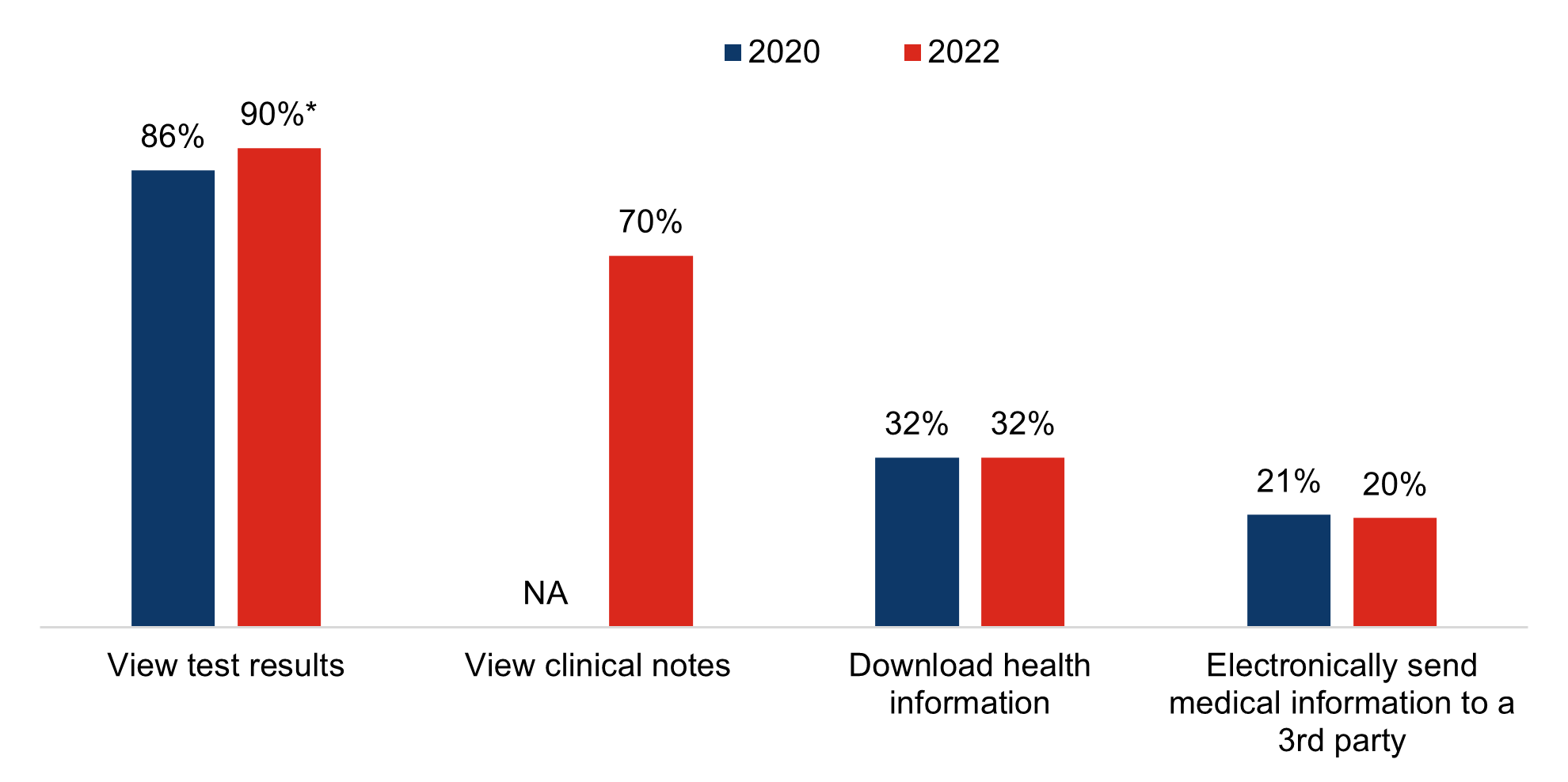
Source: HINTS 6 (2022).
Notes: Denominator represents individuals who accessed their online medical records or patient portal at least once within the past year. *Significantly different from previous year (p<0.05). Data for “View clinical notes” was not collected in 2020. In 2020, “electronically send medical information to a 3rd party” was derived from 3 survey questions and indicates whether respondents have transmitted data to at least one outside party (i.e., to another healthcare provider, caregiver, service or app). In 2022, this measure was derived from the survey question, “In the past 12 months, have you used your online medical record or patient portal to electronically send medical information to a third party (such as another health care provider, a family member, or smartphone health app)?” The response options were not mutually exclusive. see Appendix Table A1 for side-by-side data regarding uses of online medical records or patient portals between 2017 and 2022.
About 2 in 3 individuals reported having an online medical record or patient portal with their primary care provider.
FINDINGS
★ While individuals most commonly had an online medical record or patient portal through their primary care provider’s office (63%), nearly 1 in 3 individuals also reported having an online medical record or patient portal with another health care provider (32%) or insurer (29%).
★ Clinical laboratory and pharmacy online medical records or portals were the least common (reported by 26% and 23% of individuals, respectively).
★ In 2022, half of individuals had more than one online medical record or patient portal with different organization/provider types, while 1 in 5 individuals reported they did not have any online medical records or patient portals (see Appendix Table A2).
Figure 6: Organization/provider types with which individuals have an online medical record or patient portal, 2022.
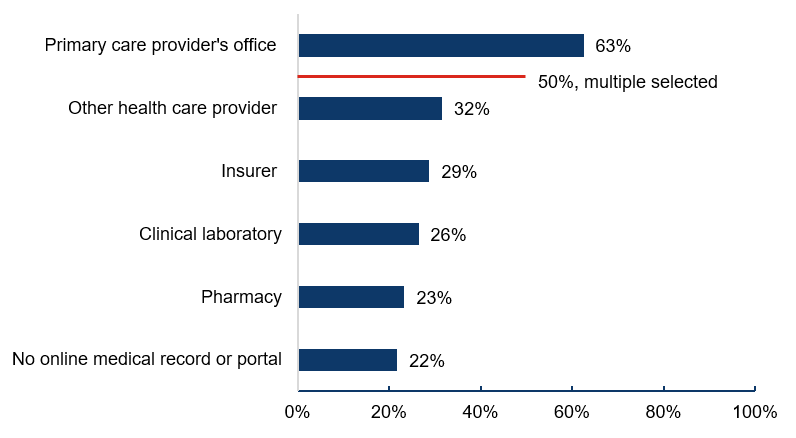
Source: HINTS 6 (2022).
Notes: Denominator excludes missing and invalid responses.
Only 2% of patients used an app to combine medical information from different patient portals or online medical records in 2022.
FINDINGS
★ The vast majority of individuals (98%) did not use an electronic personal health record or portal organizing app (such as Apple Health Records or CommonHealth) to combine medical information from different patient portals or online medical records.
Figure 7: Individuals' use of portal organizing apps to combine medical information from different patient portals or online medical records into one place, 2022.
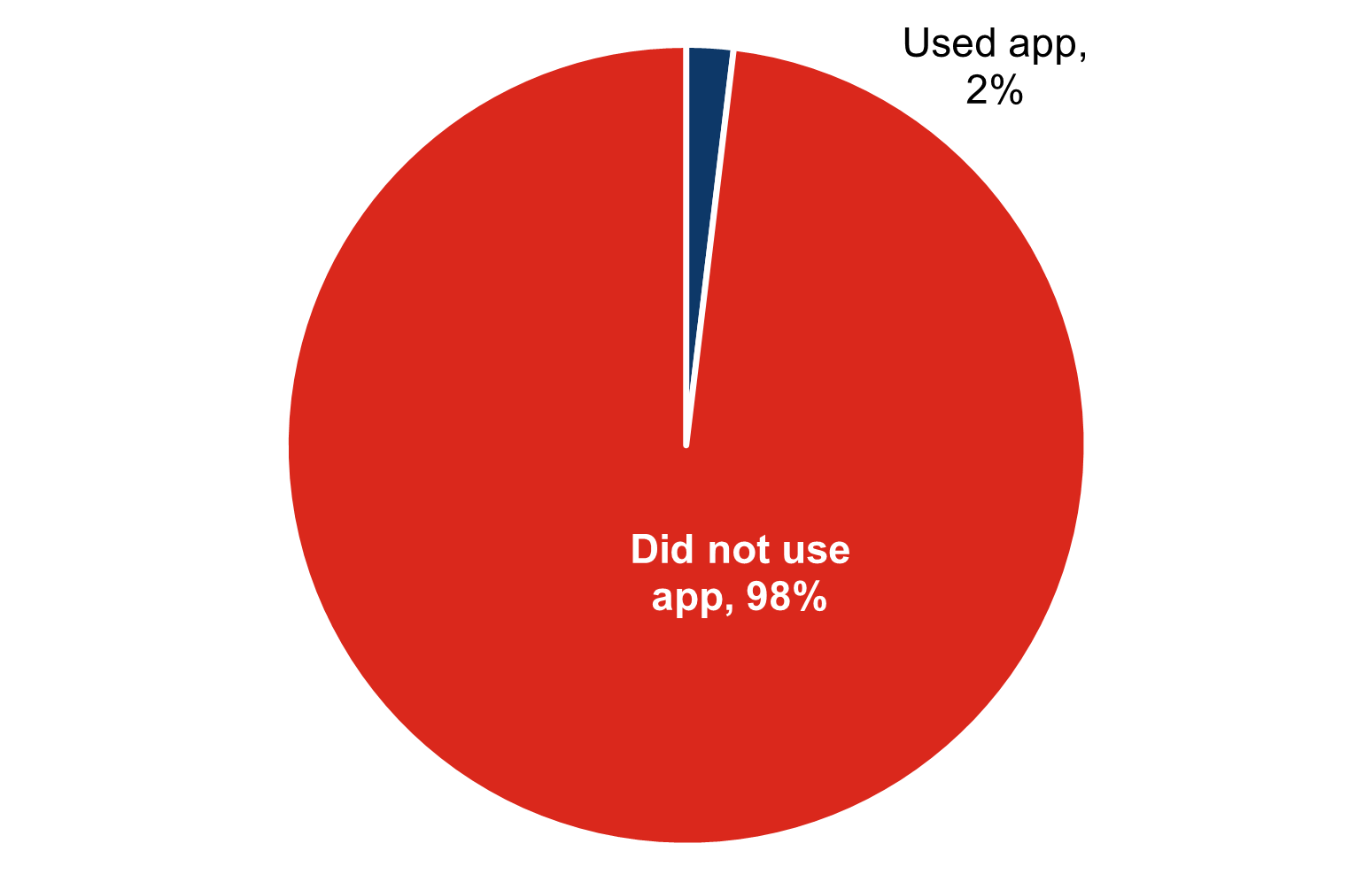
Source: HINTS 6 (2022).
Notes: Denominator excludes missing and invalid responses. "Did not use app" also includes individuals who reported only having one online medical record or patient portal.
SUMMARY
In the wake of the COVID-19 pandemic and amidst implementation of provisions in the Cures Act Final Rule (Cures Rule), new data from the 2022 HINTS provide evidence of significant advances in patient access and use of their electronic health information. In 2022, 73% of individuals reported being offered online access to their medical records (such as via a patient portal) by their health care provider or insurer— a 24% increase from 2020—and 57% accessed their online medical records or patient portal at least once in the past year—a 50% increase from 2020. Further, the share of individuals who were offered online access to their medical records but did not access them decreased by 42% since 2020. Together these findings demonstrate increased patient demand for and use of online health information by individuals in recent years.
Frequency of online medical record access also increased steadily from 2017 to 2022. Most notably, while only 10 percent of individuals who were offered and accessed their online medical record or patient portal reported accessing it 6 or more times in 2017, almost a third reported this level of frequency of access in 2022, a significant increase from 2020. While there are various reasons why patients may access their information at higher rates (e.g., having a chronic condition or multiple healthcare visits), differences in frequency of access may in part be explained by patients having more methods available to access their health information online. The Cures Rule aimed to increase patient access by promoting a secure and trustworthy infrastructure for on-the-go access to health data and enabling patients to access and manage their records using an app of their choice. Although most individuals who accessed their online medical records at least once within the prior year did so using a web-based portal, a growing portion of individuals reported using a smartphone health app to access their information. In 2022, 51% of individuals accessed their online medical records using an app (either alone or in combination with a website), which represents a 13 percentage-point increase in app-based access from 2020. These individuals reported more frequent access to their online medical records compared to those who used only a website to access their records. Forty-two percent of individuals who used an app to access their online medical records reported accessing them 6 or more times in the past year compared to 28 percent of those who used only a web-based portal, which suggests the use of apps may make it easier and more convenient for patients to track and engage with their health information.
In 2022, most individuals who accessed their online medical records or patient portals used them to view test results (90%) or clinical notes (70%), which is consistent with the most common uses of online medical records reported in 2020 (3). Fewer individuals reported using their online medical records or patient portals to download health information or electronically transmit the data to a third party. This may reflect lower patient demand for download and transmit functionalities or indicate a lack of awareness of these options for sharing their data. Low use of the transmit function in online medical records or patient portals may also indicate challenges on the receiving end, as recipients must have the technical capability to receive data and incorporate it into their systems.
Online tools enabling patient access allowed patients to stay connected with various organizations and provider types in 2022. Although nearly 2 in 3 individuals reported having an online medical record or patient portal with their primary care provider’s office, a smaller portion reported having online records with other providers, insurers, clinical labs, and pharmacies. However, it is notable that half of individuals reported having an online medical record or patient portal with more than one organization or provider type. Given the various number of organizations and providers with which patients may have online medical records or patient portals, portal organizing apps (e.g., Apple Health Records or CommonHeatlh) may be useful tools to combine medical information from these different sources. However, in 2022, 98% of all individuals reported that they did not use such an app, which may reflect patient preferences for using the online medical records or patient portals offered by their providers or a lack of awareness of these types of apps and their utility.
Despite the advances in patient access and use of their online medical records, particularly through apps, there are also opportunities for improvement. Just under half of all individuals were either not offered or did not access their online medical records or a patient portal in 2022, and several studies have identified disparities in the share of patients who report being offered and subsequently accessing their portals (4,5). Relatively low rates of downloading and transmitting health information by individuals who access their online medical records suggests a need for further education of both individuals and providers on these features. ONC provides guidance for patients and providers in the Patient Engagement Playbook, a clinically-facing tool detailing ways to facilitate easy patient enrollment and ensure that online medical records and patient portals are accessible, as well as the patient-facing Guide to Getting and Using your Health Record, which serves as a resource to guide patients through the process of accessing their online medical records. The ability of apps to integrate information and more easily share the data accessible to patients online may address the low rates of using download and transmit functions. Although very few patients took advantage of apps that can combine health information across multiple medical records or portals in 2022, this is unsurprising given that relevant provisions of the Cures Act Final Rule were in the process of being implemented by industry at that time. Therefore, we would expect to see future increases in the use of apps that would simplify access and use of patient health information, making it easier for patients to monitor and make informed decisions about their health.
DATA SOURCES AND METHODS
Data are from the National Cancer Institute’s (NCI) Health Information National Trends Survey (HINTS). Since 2003, NCI has conducted the HINTS to assess the impacts of health communication, specifically measuring: how people access and use health information, how people use information technology to manage their health and health information, and the degree to which people are engaged in health behaviors (6).
ONC staff, working with NCI, developed the survey content related to health IT use for HINTS 6. HINTS 6 (2022) data were collected from March through November 2022. The sample design for HINTS 6 (2022) consisted of two modes, with both a paper survey and web option.
The sample design for the HINTS 6 (2022) survey consisted of two-stages. In the first stage, a stratified sample of addresses was selected from a file of residential addresses. In the second-stage, one adult was selected within each sampled household. The sampling frame consisted of a database of addresses used by Marketing Systems Group (MSG) to provide a random sample of addresses. Complete data were collected from 6,252 respondents. The final overall response rate was 28.1%. Results were weighted to account for non-response and generate national estimates. More details regarding sample selection, data collection, and weighting can be found in the Methodology Report [PDF - 2.9 MB].
The analyses conducted in this data brief primarily focused on questions from section E. The questions asked in the HINTS 6 (2022) survey can be found at https://hints.cancer.gov/docs/Instruments/HINTS6-AnnotatedEnglishInstrument.pdf [PDF - 2.8 MB].
REFERENCES
- Tapuria A, Porat T, Kalra D, Dsouza G, Xiaohui S and V Curcin. Impact of patient access to their electronic health record: systematic review. Informatics for Health and Social Care. 2021;46(2): 194-206. https://doi.org/10.1080/17538157.2021.1879810.
- United States of America. H.R. 34 – 21st Century Cures Act. [Internet]. Washington D.C.: Congress.gov; 2016 [2023 Apr 17]. Available from: https://www.congress.gov/bill/114th-congress/house-bill/34.
- Johnson C, Richwine C, and V Patel. Individuals’ Access and Use of Patient Portals and Smartphone Health Apps, 2020. Office of the National Coordinator for Health Information Technology. Data Brief: 57. 2023.
- Richwine C, Johnson C, and V Patel. Disparities in patient portal access and the role of providers in encouraging access and use. Journal of the American Medical Informatics Association. 2023;30(2): 308-317. doi: 10.1093/jamia/ocac227.
- Nishii A, Campos-Castillo C, and D Anthony. Disparities in patient portal access by US adults before and during the COVID-19 pandemic. Journal of the American Medical Informatics Association. 2022 Dec; 5(4): 1-11. doi: https://academic.oup.com/jamiaopen/article/5/4/ooac104/6887151.
- National Cancer Institute. Health Information National Trends Survey. https://hints.cancer.gov/. [Accessed 7th Aug 2023].
ACKNOWLEDGEMENTS
The authors are with the Office of Technology, within the Office of the National Coordinator for Health Information Technology. The data brief was drafted under the direction of Mera Choi, Director of the Technical Strategy and Analysis Division, Vaishali Patel, Deputy Director of the Technical Strategy and Analysis Division, and Wesley Barker, Chief of the Data Analysis Branch.
SUGGESTED CITATION
Strawley C. and Richwine C. Individuals’ Access and Use of Patient Portals and Smartphone Health Apps, 2022. Office of the National Coordinator for Health Information Technology. Data Brief: 69. 2023.
APPENDIX
Appendix Table A1: Individuals' use of online medical record or patient portal to view, download, or transmit information, 2020-2022.

Source: HINTS 5, Cycles 1-4 (2017-2020) and HINTS 6 (2022).
Notes: Denominator represents individuals who accessed their online medical record or patient portal at least once within the last year. Data for “View test results” was not collected in 2018. Data for “View clinical notes” was not collected in 2017-2020. * In 2017-2020 this measure was derived from 3 survey questions and indicates whether respondents have transmitted data to at least one outside party (i.e., to another healthcare provider, caregiver, service or app). In 2022, this measure was derived from the survey question, “In the past 12 months, have you used your online medical record or patient portal to electronically send medical information to a third party (such as another health care provider, a family member, or smartphone health app)?”
Appendix Table A2: Number of organizations/provider types with which individuals have an online medical record or patient portal, 2022.

Source: HINTS 6 (2022).
Notes: Denominator excludes missing or invalid responses. Organization/provider types considered include primary care provider, other health care provider, insurer, clinical laboratory, and pharmacy.


